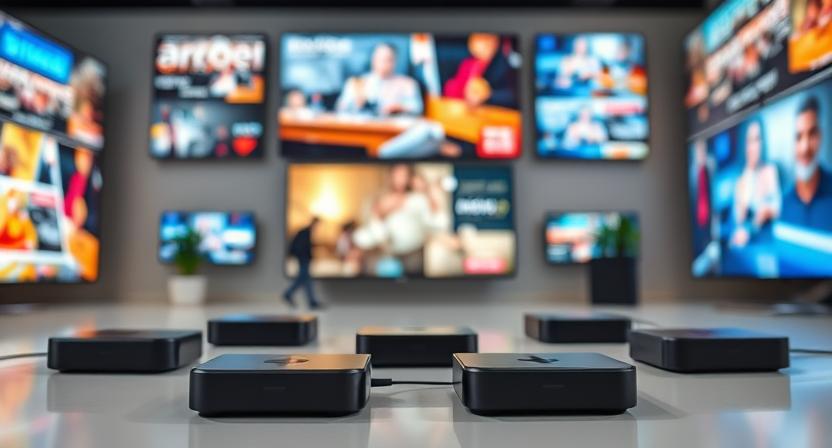How Android Boxes Elevate Interactive Advertising Experiences
In today’s connected world, consumers expect personalized, engaging, and immersive brand experiences. The Android Box for Advertising has become a cornerstone in achieving this transformation, empowering advertisers to create interactive, data-driven campaigns that connect audiences with brands in meaningful ways. From touchscreen kiosks to AI-driven displays, Android boxes are redefining how digital advertising delivers engagement and results.
1. The Evolution of Interactive Advertising
Interactive advertising has evolved from passive content to dynamic experiences where users actively engage with digital media. This shift demands smarter infrastructure capable of supporting advanced interactivity, automation, and data feedback.
The Android Box for Advertising provides exactly that — a compact yet powerful device that runs sophisticated applications, integrates with sensors, and delivers seamless multimedia playback for any advertising environment.
2. Why Android Technology Powers Interactivity
Android’s open-source platform allows unparalleled flexibility for advertisers and developers. It supports custom applications, multitouch interfaces, and AI integrations, making it ideal for interactive advertising ecosystems.
Unlike traditional signage players, Android devices enable real-time two-way interaction, where users can browse, tap, swipe, or even use voice commands to control the content they see. This functionality transforms passive viewers into active participants, dramatically increasing engagement rates and brand recall.
3. Touchscreen Signage and Smart Displays
Modern interactive advertising displays rely on responsive touchscreen technology. With the Android Box for Advertising, businesses can deploy interactive kiosks, retail catalogs, and product customization screens without complex PC-based systems.
Touch-based experiences allow users to explore product details, configure options, or even make purchases directly from the display — creating a frictionless path from awareness to conversion.
4. Voice and Gesture-Based Engagement
Beyond touch, Android platforms support gesture and voice recognition through AI-driven interfaces. For instance, in airports or malls, users can ask for directions, promotions, or event information using natural language.
Gesture control adds another layer of accessibility, allowing customers to interact with digital screens without physical contact — an especially valuable feature in post-pandemic environments.
5. AI-Powered Personalization
Artificial intelligence has revolutionized the way advertising adapts to user behavior. The Android Box for Advertising integrates AI tools that analyze demographics, dwell time, and interaction data in real time.
This intelligence enables the system to personalize content automatically — for example, showcasing fashion items to younger viewers or family products to parents. AI-powered smart engagement platforms ensure that every interaction feels tailored, relevant, and memorable.
6. Connecting Online and Offline Marketing
Interactive Android signage bridges the gap between online and offline marketing. By integrating with mobile apps, QR codes, and social media, brands can extend digital engagement beyond the screen.
Customers can scan QR codes to unlock discounts, follow brand accounts, or participate in online campaigns. This seamless integration boosts brand consistency and drives measurable cross-channel engagement.
7. Real-Time Analytics and Insights
Every interaction with a touchscreen or sensor-equipped display generates valuable data. The Android Box for Advertising collects metrics on user engagement, time spent per session, and content preferences.
These analytics feed into centralized dashboards, helping advertisers understand audience behavior and refine future campaigns. With AI-assisted analytics, businesses can forecast trends, optimize content placement, and increase ROI across all touchpoints.
8. Multi-Screen Synchronization and Immersive Campaigns
Interactive campaigns often span multiple screens and devices. Android-based systems can synchronize content across LED walls, video kiosks, and mobile devices for unified storytelling.
Imagine a campaign where a user interacts with a storefront touchscreen, triggering complementary visuals on a nearby video wall — creating a cohesive and immersive brand experience. The android signage experience turns retail spaces and public venues into interactive digital ecosystems.
9. Integration with IoT Devices and Sensors
Interactivity extends beyond the display itself. The Android Box for Advertising connects with IoT sensors such as cameras, motion detectors, and RFID readers.
These devices can trigger content automatically — for instance, displaying ads when a person approaches or showing product information when an item is picked up. This context-aware marketing bridges the physical and digital worlds through real-time environmental awareness.
10. Enhanced Accessibility and User Experience
Smart signage powered by Android supports accessibility features such as voice assistance, multilingual interfaces, and adaptive display settings. These capabilities ensure inclusivity and cater to diverse audiences, improving user satisfaction and engagement.
Brands leveraging the Android Box for Advertising benefit from technology that not only attracts attention but also provides a smooth, intuitive, and inclusive user experience for everyone.
11. Scalability and Centralized Control
As businesses expand, managing multiple interactive displays becomes a challenge. Android’s cloud-connected architecture simplifies scalability.
Administrators can deploy new devices, push updates, and monitor engagement metrics from a central control panel. Whether managing a local store or an international ad network, the touchscreen digital signage infrastructure scales efficiently while maintaining consistency and reliability.
12. Future Trends: The Next Phase of Interactive Advertising
The future of interactivity lies in AI-driven automation, augmented reality, and predictive engagement. Next-generation Android advertising systems will feature emotion recognition, facial analytics, and adaptive storytelling based on audience reactions.
These innovations will make every advertising moment more human, responsive, and emotionally resonant — pushing digital engagement beyond traditional boundaries.
Conclusion: The Future of Audience Engagement
Interactivity has become the new currency of digital advertising. With the Android Box for Advertising, brands gain access to a platform that combines AI, touch, and data analytics to deliver unforgettable experiences.
Looking to create interactive advertising that captivates your audience? Contact our team today to explore Android-based digital signage solutions that elevate engagement, performance, and brand impact.
READ MORE
Why Android Boxes Are Essential for Next-Gen Advertising Platforms
How Android Boxes Drive Innovation in Smart Advertising Systems
The Impact of Android Boxes on Interactive Advertising Experiences
Enhancing Retail Engagement with Android Box for Advertising
How Android Boxes Enable Smarter, Data-Driven Advertising Displays
The Role of Android Boxes in Transforming Digital Signage Advertising
How Android Boxes Power the Future of Smart Advertising Displays
Quick Links





.png)
.png)






.png)

.png)














